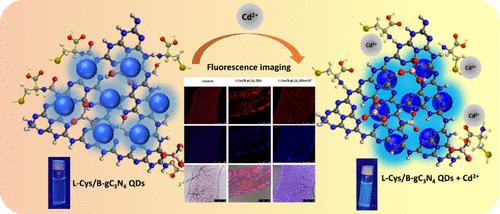l-半胱氨酸功能化硼掺杂石墨氮化碳量子点:用于水中镉检测的生物相容性荧光传感器
IF 3.9
3区 工程技术
Q2 ENGINEERING, CHEMICAL
引用次数: 0
摘要
采用简单的热合成方法合成了硼掺杂石墨氮化碳量子点(B-gC3N4量子点),并通过EDC/NHS偶联反应被l-半胱氨酸(l-Cys)功能化。得到的l-Cys/B-gC3N4量子点具有28%的高量子产率、良好的水溶性、耐光漂白和离子强度。这些量子点被用作荧光探针,用于检测水中痕量的Cd2+离子。由于螯合增强荧光(CHEF)机制,它们在Cd2+离子的作用下表现出荧光信号增强。该传感器对Cd2+离子的检测线性范围为0.1 ~ 0.7 μM,检测限为0.23 μM,结合常数为9.83 × 105 M-1。细胞毒性实验表明,l-Cys/B-gC3N4量子点,无论是单独存在还是Cd2+存在,都没有表现出DNA损伤或细胞膜破坏,证实了它们的无毒性质。此外,该传感器在实际水样中检测Cd2+的精度很高,回收率在95 ~ 106%之间。本工作提出了一种可持续的、生物相容性的、经济高效的荧光探针,用于实时监测环境水源中的镉离子。本文章由计算机程序翻译,如有差异,请以英文原文为准。

l-Cysteine-Functionalized Boron-Doped Graphitic Carbon Nitride Quantum Dots: A Biocompatible Fluorescent Sensor for Cadmium Detection in Water
Boron-doped graphitic carbon nitride quantum dots (B-gC3N4 QDs) are synthesized through a simple thermal process and functionalized with l-Cysteine (l-Cys) via an EDC/NHS coupling reaction. The resulting l-Cys/B-gC3N4 QDs demonstrate a high quantum yield of 28%, excellent water solubility, and resistance to photobleaching and ionic strength. These quantum dots are employed as fluorescent probes for detecting Cd2+ ions at trace levels in water. They exhibit a fluorescence signal enhancement in response to Cd2+ ions, attributed to a chelation-enhanced fluorescence (CHEF) mechanism. The sensor detects Cd2+ ions within a linear range of 0.1–0.7 μM, with a detection limit of 0.23 μM and a binding constant of 9.83 × 105 M–1. Cytotoxicity assays reveal that l-Cys/B-gC3N4 QDs, both alone and in the presence of Cd2+, show no DNA damage or cell membrane disruption, confirming their nontoxic nature. Furthermore, the sensor achieves high accuracy in detecting Cd2+ in real water samples, with recovery rates ranging from 95 to 106%. This work presents a sustainable, biocompatible, and cost-effective fluorescent probe for real-time monitoring of cadmium ions in environmental water sources.
求助全文
通过发布文献求助,成功后即可免费获取论文全文。
去求助
来源期刊

Industrial & Engineering Chemistry Research
工程技术-工程:化工
CiteScore
7.40
自引率
7.10%
发文量
1467
审稿时长
2.8 months
期刊介绍:
ndustrial & Engineering Chemistry, with variations in title and format, has been published since 1909 by the American Chemical Society. Industrial & Engineering Chemistry Research is a weekly publication that reports industrial and academic research in the broad fields of applied chemistry and chemical engineering with special focus on fundamentals, processes, and products.
 求助内容:
求助内容: 应助结果提醒方式:
应助结果提醒方式:


